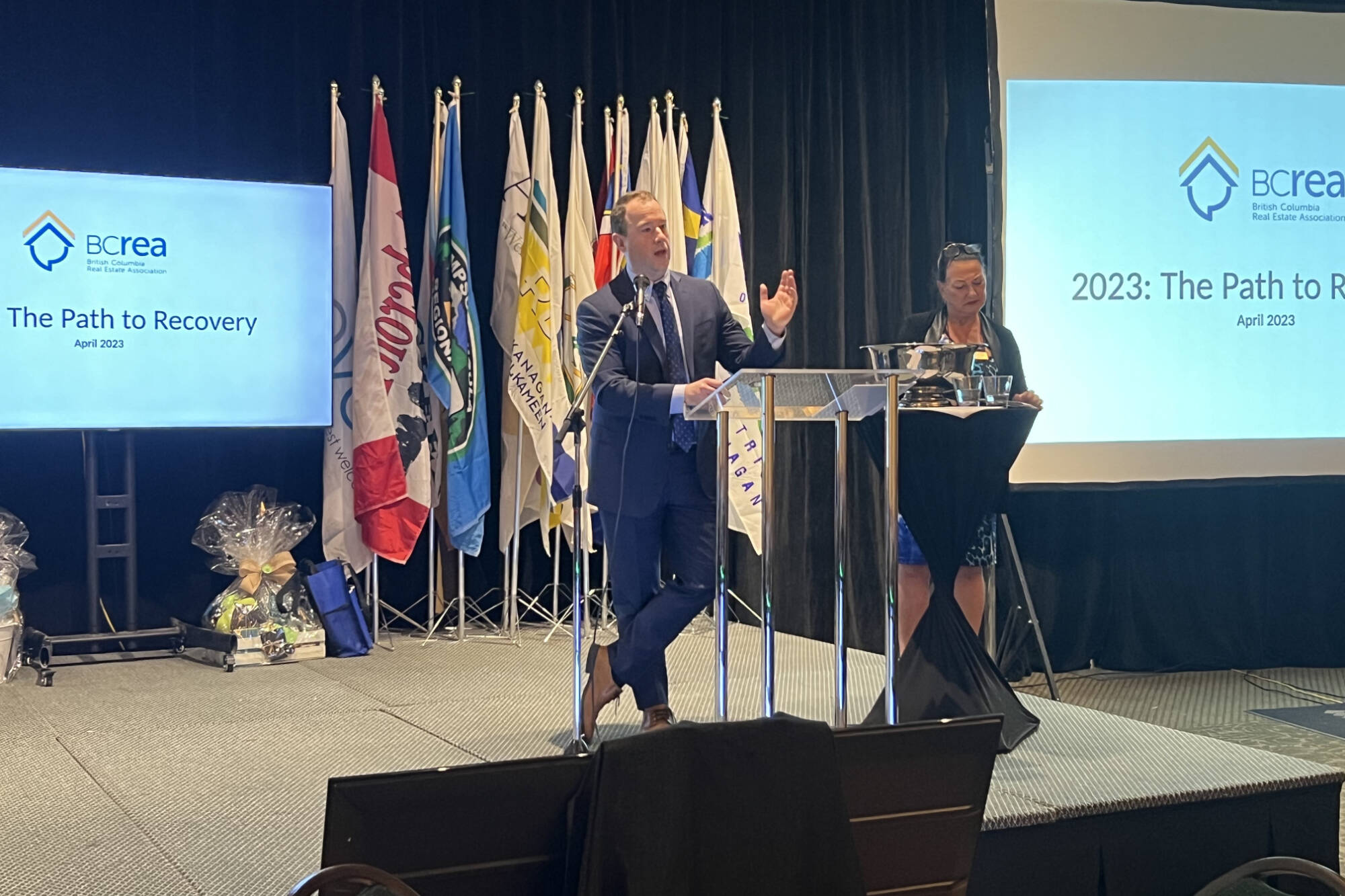The Southern Interior Local Government Association (SILGA) conference continued in Vernon Thursday, April 27, with a discussion on the path to recovery in the housing market.
Brendon Ogmundson, chief economist for the BC Real Estate Association, gave an hour-long presentation Thursday at the Prestige Vernon Lodge and Conference Centre, where he discussed to a room full of delegates the state of B.C.’s economy, the looming economic recession, and the implications for the housing market.
Ogmundson called today’s current economic climate “the most forecasted recession in history,” and while many ask whether the recession has already arrived, metrics like unemployment rates suggest that it hasn’t.
“We’re not there yet. The unemployment rate in Canada is still a record low,” he said.
Ogmundson pointed out what has been clear for some time: the Bank of Canada is trying to slow down the economy to bring down inflation, and is doing so by raising interest rates.
Ogmundson said these measures are having the effect of slowing consumer spending.
“We’ve seen some of this in B.C. already,” he said. “So maybe we’re starting to see early signs of the economy starting to slow down.
“When might the Bank of Canada lower rates? Probably not until we’ve seen inflation materially come down to at least two per cent or below two per cent for an extended period of time.”
While the COVID-19 pandemic presented a number of economic challenges, it had some financial saving graces for Canadians. Ogmundson said income in fact spiked for a couple quarters during the onset of COVID-19 as governments transferred “a lot of money” to households to see them through the worst part of the pandemic. However, most couldn’t spend this income because large parts of the economy (restaurants, tourism) were shut down. That led to a lot of savings being stashed in Canadian residents’ bank accounts.
“That’s going to create a bit of a buffer so as costs of living rise, interest rates go up, we have this kind of buffer that’s helping households absorb some of that shock,” Ogmundson said.
Ogmundson noted the population growth in the Okanagan has been “exploding,” which is putting a strain on the housing market. Due to high demand, home prices in the Interior went up about 40 per cent since the start of the pandemic.
Ogmundson says there’s good news when it comes to “transitory shocks” affecting the economy — shocks such as high gas prices.
“All of the transitory shocks that were causing inflation to be much higher over the past year are now heading in the other direction,” he said. “And crucially we’re starting to see major improvement in supply chains.”
Attempting to forecast the future, Ogmundson laid out both a pessimistic and an optimistic scenario. In the pessimistic scenario, there is double-digit unemployment rates and inflation, and the Bank of Canada “can’t react the way it normally would because inflation is so high.”
In the optimistic scenario, there is no recession and a very low unemployment rate.
“No surprise that that scenario is pretty mechanical, we have a much stronger recovery in home sales, much stronger recovery in prices.”
Ogmundson said his team put together economic models in November 2022, so there has been time to see how things are tracking. In the short term, he said “they’re actually tracking a little better than even our most optimistic scenario.” He said this is slightly confusing as there has been no movement on rates, “but we’re already seeing sales start a very strong recovery from the last couple months, and we’re seeing prices … start to recover as well.”
But the news is worse in the long run: “We have really strong population growth at a time when we haven’t been planning. So we’ve had a past decade where all we talked about at the government level is producing demand and we haven’t done anything to fix the supply side.”
Ogmundson pointed out the dire situation of the rental market, saying in Kelowna we’ve seen rent go up $1,000 a month since 2019, “and it’s coming at a time when the communities of the Interior and Okanagan are the fastest growing communities in Canada.”
What can be done about this? Ogmundson joked that we need to build a time machine, go back 10 years and start increasing the housing stock.
“Just to get back to status quo affordability … we would have to increase (building) completions — so not starts, but getting units to the market — by 25 per cent over baseline every year for five years. So we’d have to have a record amount of building every year for the next five years, at a time when interest rates are at 20 year highs.
“In the long run we just simply don’t have enough housing, and it’s going to take a while to get there. We’re not going to fix this problem in two years when it takes five years to build new housing,” Ogmundson said.
Ogmundson also pointed out that B.C. has the highest job vacancy rate for construction workers in Canada, and said something like 15 per cent of the construction and trades labour force is set to retire in the next five years. Even if we have the zoning and land, we may not have the people needed to build housing fast enough.
He’d like to see not only an increase in the total amount of housing, but a speeding up of the timeline needed to get housing to market.
READ MORE: Update to B.C mental health policy, more resolutions passed at SILGA in Vernon
READ MORE: Vernon hosting municipal counterparts for SILGA

